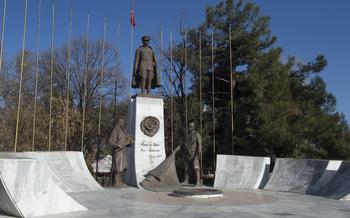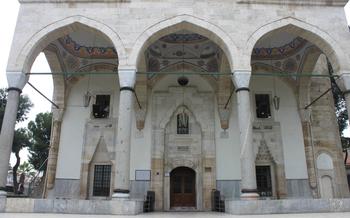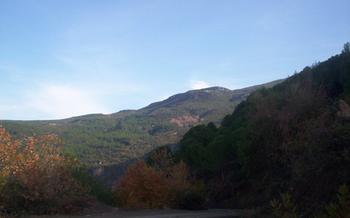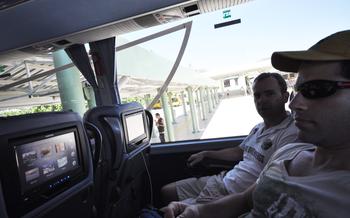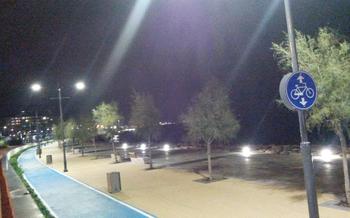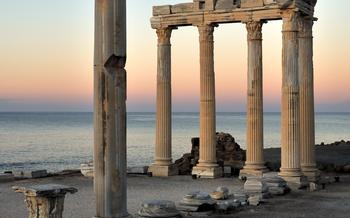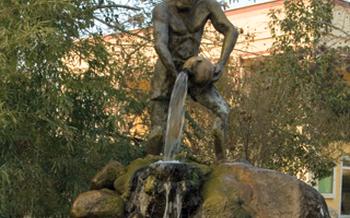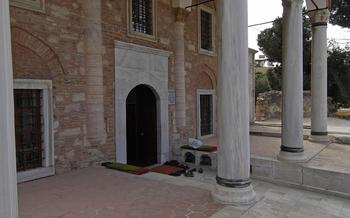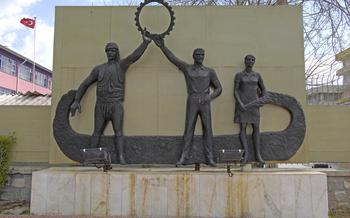
Yakaören Ruins
- Yakaören Ruins: A Journey Through Time
- Uncovering the Ancient City of Yakaören
- Exploring the Ruins of Yakaören
- The Amphitheater: A Stage for Ancient Performances
- The Agora: The Heart of Yakaören's Commerce
- The Temple of Apollo: A Sacred Sanctuary
- Architectural Style
- Religious Rituals
- Connection to the Oracle of Delphi
- The Necropolis: A City of the Dead
- The Aqueduct: A Masterpiece of Engineering
- The City Walls: Fortified Defense
- The Mosaics of Yakaören: A Visual Masterpiece
- The Museum of Yakaören: A Treasure Trove of Artifacts
- Festivals and Events in Yakaören
- Local Cuisine: A Taste of Yakaören's Flavors
- Accommodation in Yakaören: A Range of Options
- Insider Tip: Discover Hidden Gems
Yakaören Ruins: A Journey Through Time
Immerse yourself in the captivating allure of the Yakaören Ruins, a testament to Turkey's rich historical heritage. Embark on a journey through time as you explore the remnants of this ancient city, a symbol of human ingenuity and creativity. Situated in the heart of Isparta, Yakaören beckons with its well-preserved ruins and intriguing stories waiting to be uncovered.
Historical Significance
Yakaören's historical significance stems from its role as a major city in ancient Pisidia, a region renowned for its fierce independence and cultural diversity. Founded in the 3rd century BC, Yakaören flourished as a center of trade and culture, leaving behind a legacy of impressive architecture, intricate mosaics, and fascinating inscriptions.
Location
Nestled amidst the picturesque landscapes of Isparta, Yakaören's ruins are easily accessible, inviting history enthusiasts and curious travelers alike to unravel its secrets. Located just 12 kilometers from the city center, Yakaören can be reached by car or public transportation, making it a convenient destination for a day trip or an extended exploration.
Accessibility
Yakaören's ruins are open to the public, offering visitors the chance to wander through the remnants of this ancient city and marvel at its architectural wonders. With well-maintained paths and informative signage, exploring Yakaören is both enjoyable and educational, providing a glimpse into the lives of those who once called this place home.
Uncovering the Ancient City of Yakaören
Archaeological excavations at Yakaören have been ongoing for several decades, revealing a wealth of information about the ancient city. The site was first explored in the 19th century by European travelers, who noted the presence of impressive ruins and artifacts. In the early 20th century, systematic excavations began, led by Turkish archaeologists. These excavations have uncovered numerous structures, including temples, theaters, and marketplaces, as well as a vast array of artifacts, such as pottery, coins, and inscriptions.
Among the most significant discoveries at Yakaören is the Temple of Apollo, which was dedicated to the Greek god of music and prophecy. The temple is a well-preserved example of classical Greek architecture, with its iconic columns and pediments. Excavations at the temple have uncovered numerous artifacts, including statues, inscriptions, and offerings, which provide valuable insights into the religious practices of the ancient city.
Another important discovery at Yakaören is the Agora, the central marketplace of the city. The Agora is a large, open space surrounded by shops and stalls, where merchants sold their wares and people gathered to socialize and conduct business. Excavations at the Agora have uncovered a variety of artifacts, including pottery, coins, and weights and measures, which provide evidence of the economic activities that took place in the city.
Ongoing research at Yakaören continues to shed light on the history and culture of the ancient city. Archaeologists are working to uncover more structures and artifacts, and to interpret the findings within the broader context of ancient Greek and Roman civilization.
Exploring the Ruins of Yakaören
The ancient city of Yakaören, with its well-preserved ruins, offers a glimpse into the urban planning and architecture of the past. The city's layout is characterized by a grid system of streets, with the main thoroughfare, the Cardo Maximus, running east-west and the Decumanus Maximus, running north-south. These streets intersect at the heart of the city, forming the agora, or marketplace.
Among the notable structures in Yakaören are the amphitheater, the agora, the Temple of Apollo, and the necropolis. The amphitheater, located on the western edge of the city, is a well-preserved example of Roman architecture, with a seating capacity of over 5,000 spectators. The agora, situated at the intersection of the Cardo Maximus and the Decumanus Maximus, was the center of commercial activity in Yakaören. It features a colonnaded courtyard surrounded by shops and stalls.
Throughout the ruins, intriguing inscriptions in Greek and Latin provide valuable insights into the lives and customs of Yakaören's inhabitants. These inscriptions include dedications to gods, epitaphs, and even graffiti, offering a glimpse into the personal stories of the people who once called this city home.
The Amphitheater: A Stage for Ancient Performances
The amphitheater is a prominent feature of the Yakaören ruins, offering a glimpse into the city's rich cultural life. Built to host theatrical performances, musical concerts, and gladiatorial contests, it boasts impressive architectural features that showcase the ingenuity of ancient builders.
Constructed in a horseshoe shape, the amphitheater could accommodate thousands of spectators. Its tiered seating, carefully designed for optimal acoustics, ensured that even those in the furthest rows could hear the performers clearly. The stage, with its intricate backdrop and decorative elements, provided a grand setting for the diverse entertainments that took place here.
The amphitheater's acoustics are particularly noteworthy. The carefully calculated angles of the seating and the use of specialized materials such as ceramic tiles and marble helped to amplify and distribute sound throughout the space. This ensured that the actors' voices and the music could be heard clearly by all in attendance, creating an immersive and engaging experience for the audience.
The Agora: The Heart of Yakaören's Commerce
The agora, or marketplace, was the bustling center of Yakaören's commercial activity. This sprawling area was a beehive of trade, where merchants from near and far gathered to buy and sell their wares. The agora was not merely a place of commerce but also a social hub, where people from all walks of life came together to exchange news, ideas, and laughter.
The layout of the agora was carefully planned, with wide walkways lined with shops and stalls. These stalls were a treasure trove of goods, from exotic spices and handcrafted textiles to locally produced pottery and jewelry. The air was filled with the sounds of haggling, laughter, and the clinking of coins as merchants touted their wares and customers bargained for the best prices.
Beyond its commercial significance, the agora served as a vital social space. It was here that the community gathered for festivals, celebrations, and public announcements. Philosophers and orators shared their ideas and wisdom, while musicians and performers entertained the crowds. The agora was a place where people came together to connect, share stories, and strengthen the bonds of community.
The Temple of Apollo: A Sacred Sanctuary
The Temple of Apollo, dedicated to the Greek god of prophecy, stands as a testament to Yakaören's rich religious and cultural heritage. Built in the 2nd century AD, this awe-inspiring structure is a testament to the architectural prowess of the ancient Greeks.
Architectural Style
The temple showcases the distinctive Doric architectural style, characterized by its simplicity and grandeur. Its imposing columns, adorned with delicate fluting, support a triangular pediment that once housed intricate sculptures depicting scenes from Greek mythology. The well-preserved remains of the temple offer a glimpse into the remarkable craftsmanship of ancient builders.
Religious Rituals
The Temple of Apollo served as a sacred site for religious rituals and ceremonies. Devotees would gather here to seek guidance and divine intervention from the oracle of Apollo. Priests, believed to be imbued with the god's wisdom, would interpret the enigmatic utterances of the oracle, providing advice and prophecies to those who sought them.
Connection to the Oracle of Delphi
Yakaören's Temple of Apollo was closely associated with the renowned oracle of Delphi, one of the most significant religious sanctuaries in the ancient world. It is believed that the oracles of both temples were connected, and that the priests of Yakaören may have sought guidance from their counterparts in Delphi. This connection further underscores the temple's importance as a center of religious devotion and spiritual guidance.
The Necropolis: A City of the Dead
Location and layout:
The necropolis, or city of the dead, of Yakaören is situated just outside the city walls, stretching to the east. It encompasses a vast area, with numerous tombs and burial chambers arranged in orderly rows. The layout of the necropolis reflects the social hierarchy of the ancient city, with grand and elaborate tombs for the wealthy and influential individuals, and simpler graves for the common folk.
Types of tombs:
The tombs in the Yakaören necropolis vary in size, shape, and design, showcasing the diverse burial practices of the ancient inhabitants. Some of the most common types of tombs include:
- Rock-cut tombs: These are tombs carved directly into the natural rock formations, creating a series of chambers and niches for the deceased.
- Chamber tombs: These consist of underground chambers, accessed through a staircase or a sloping passageway, and often contain multiple burial niches.
- Sarcophagus tombs: In these tombs, the deceased were laid to rest in stone or marble sarcophagi, often elaborately decorated with carvings and inscriptions.
Funerary customs:
The funerary customs practiced in Yakaören shed light on the beliefs and rituals associated with death and the afterlife. The bodies of the deceased were typically washed and anointed with oils and perfumes, before being wrapped in linen shrouds or placed in wooden coffins. Grave goods, such as jewelry, pottery, and personal belongings, were often included in the tombs to accompany the deceased into the next world.
The Aqueduct: A Masterpiece of Engineering
The aqueduct of Yakaören is not just a remarkable feat of ancient engineering but also a testament to the ingenuity and resourcefulness of the city's inhabitants. Constructed with precision and meticulousness, this awe-inspiring structure played a pivotal role in meeting the daily water needs of Yakaören.
Built using locally sourced stones, the aqueduct stretched for several kilometers, bringing fresh water from a distant spring to the city. Its design showcased an intricate system of channels, tunnels, and arched bridges, all working in harmony to ensure a steady flow of water.
The aqueduct's construction involved a deep understanding of hydraulics and gravity. The builders carefully calculated the slope and gradient of the channels to ensure a consistent flow rate, while the use of arches allowed the aqueduct to navigate uneven terrain and obstacles.
The aqueduct not only supplied water for drinking and domestic use but also played a vital role in irrigation, enabling the cultivation of crops and the flourishing of agriculture in the surrounding region. Its presence transformed Yakaören into a prosperous and self-sufficient city.
Today, the ruins of the aqueduct stand as a testament to the remarkable engineering prowess of the ancients. Visitors can marvel at the precision and scale of this ancient marvel, gaining a glimpse into the ingenuity and resourcefulness that shaped the city of Yakaören.
The City Walls: Fortified Defense
The city walls of Yakaören stand as a testament to the city's strategic importance and its ability to withstand attacks. Constructed using local stone and reinforced with towers and gates, these formidable fortifications provided a strong defense against potential invaders.
The walls encircled the entire city, forming a protective barrier that safeguarded its inhabitants and their precious possessions. Their thickness and height made them nearly impenetrable, deterring potential attackers and ensuring the city's security.
The placement of the city walls was carefully considered, taking advantage of the natural topography. Built along the city's perimeter, they followed the contours of the land, maximizing their defensive capabilities.
Strategically positioned gates provided controlled access to the city, allowing for the regulation of movement and the monitoring of visitors. These gates were often fortified with additional towers and guards, further enhancing the city's defenses.
The city walls of Yakaören not only served a practical purpose but also held symbolic significance. They represented the city's strength, resilience, and determination to protect its people and way of life.
Today, these ancient walls stand as a reminder of Yakaören's rich history and its ability to endure through the ages. While they may no longer serve their original defensive purpose, they continue to captivate visitors with their grandeur and resilience.
The Mosaics of Yakaören: A Visual Masterpiece
Artistic Styles The mosaics of Yakaören showcase a diverse range of artistic styles, reflecting different periods and influences. Geometric patterns, intricate floral motifs, and scenes depicting mythological tales and everyday life adorn the floors and walls of various buildings throughout the city.
Depictions and Symbolism The mosaics offer valuable insights into the beliefs, customs, and daily life of the ancient inhabitants of Yakaören. They depict scenes of hunting, feasting, religious rituals, and mythological creatures, providing glimpses into the rich cultural heritage of the city.
Conservation Efforts Recognizing the significance of these artistic treasures, extensive conservation efforts have been undertaken to preserve and restore the mosaics. Skilled artisans meticulously clean, repair, and document each mosaic, ensuring their preservation for future generations to appreciate.
The Museum of Yakaören: A Treasure Trove of Artifacts
The Museum of Yakaören is a must-visit attraction for anyone interested in the rich history and culture of the ancient city. Housed in a beautifully restored Ottoman-era building, the museum showcases an impressive collection of artifacts excavated from the site, providing visitors with a glimpse into the lives and traditions of Yakaören's inhabitants.
The museum's collection includes a wide range of items, from intricate pottery and jewelry to sculptures, tools, and building materials. Particularly noteworthy are the well-preserved mosaics depicting scenes from mythology and everyday life, offering a glimpse into the artistic prowess of Yakaören's artisans.
In addition to the artifacts, the museum also features interactive exhibits and multimedia presentations that provide visitors with a deeper understanding of the history and significance of Yakaören. These exhibits cover various aspects of the city's life, including its religious practices, economic activities, and social customs.
The Museum of Yakaören is a valuable resource for researchers and history enthusiasts alike. It not only preserves and displays the tangible remains of the city's past but also brings its stories to life, allowing visitors to connect with the people who lived here centuries ago.
Festivals and Events in Yakaören
Yakaören's vibrant culture comes alive during its many festivals and events, offering visitors a chance to immerse themselves in the region's rich traditions and customs. One of the most significant events is the annual Yakaören Culture and Arts Festival, held every summer. This lively celebration showcases local music, dance, and handicrafts, providing a platform for local artists to share their talents. Visitors can enjoy traditional Turkish folk music performances, watch mesmerizing dance troupes, and browse an array of handmade crafts and souvenirs. Another highlight is the Yakaören Grape Festival, held in September to celebrate the region's renowned grape harvest. This colorful festival features grape-themed events, wine tasting, and traditional grape-stomping competitions. Visitors can indulge in freshly pressed grape juice, sample local wines, and witness the lively atmosphere as locals gather to celebrate the fruits of their labor.
Local Cuisine: A Taste of Yakaören's Flavors
Yakaören's culinary scene is a delectable blend of traditional Turkish flavors and regional specialties. Embark on a gastronomic journey and savor the mouthwatering dishes that have been passed down through generations.
Begin your culinary adventure with Isparta kebabs, tender morsels of marinated meat grilled to perfection. The kol böreği, a local pastry stuffed with cheese and herbs, is a must-try for its crispy layers and savory filling.
Savor the flavors of Isparta güveci, a hearty stew made with lamb, vegetables, and aromatic spices, all simmered to perfection in a clay pot. Indulge in the keşkek, a traditional dish made from wheat, meat, and chickpeas, served with a dollop of yogurt.
For a sweet treat, delight in the Isparta güllaçı, a delicate dessert made with layers of filo pastry soaked in rose-scented milk syrup. Pair your meal with a glass of Isparta gül suyu, a refreshing rosewater drink that is a local specialty.
To experience the authentic flavors of Yakaören, venture into the local markets, where you can find fresh produce, spices, and traditional sweets. Engage with the friendly vendors and immerse yourself in the vibrant atmosphere of local life.
Whether you prefer dining in traditional restaurants or savoring street food delicacies, Yakaören offers a culinary experience that will tantalize your taste buds and leave you craving for more.
Accommodation in Yakaören: A Range of Options
Yakaören offers a range of accommodation options to suit every budget and preference. Visitors can choose from comfortable hotels and guesthouses to cozy bed and breakfasts. The town's friendly locals are renowned for their warm hospitality and are always willing to assist visitors with finding the best places to stay.
For those seeking a luxurious experience, the Yakaören Palace Hotel offers elegant rooms and suites adorned with traditional Turkish décor. The hotel boasts a rooftop terrace with panoramic views of the city and the surrounding countryside. For a more intimate stay, the Rose Garden Pension offers charming rooms with private balconies overlooking the town's beautiful rose gardens.
Budget-conscious travelers will find a variety of affordable options in Yakaören. The Yakaören Hostel offers dormitory-style accommodations and private rooms, while the Yakaören Guesthouse provides simple yet comfortable rooms with shared bathrooms.
No matter where you choose to stay, you'll find that the people of Yakaören are always ready to welcome you with open arms. The town's vibrant atmosphere and rich cultural heritage make it an ideal destination for travelers seeking an authentic Turkish experience.
Tips for Finding the Best Deals
To get the most out of your accommodation experience in Yakaören, consider the following tips:
- Book your accommodation in advance, especially during the peak tourist season.
- Look for discounts and special offers, which are often available online or through travel agents.
- Ask about local guesthouses and homestays, which often offer budget-friendly rates.
- Consider staying in a nearby town or village to save on accommodation costs.
- Take advantage of the town's public transportation system to explore the city.
Insider Tip: Discover Hidden Gems
Beyond the main attractions, Yakaören offers a wealth of hidden gems waiting to be discovered. Venture off the beaten path and explore the lesser-known corners of the ancient city. Engage with the locals, who are proud to share their knowledge and stories. Consider hiring a local guide, as they can take you to secret spots and provide insights into the city's history and culture that you might miss on your own. These guides can lead you to the best viewpoints, offering breathtaking panoramas of the surrounding countryside. With a little exploration, you'll uncover the true essence of Yakaören and create unforgettable memories that will last a lifetime.
